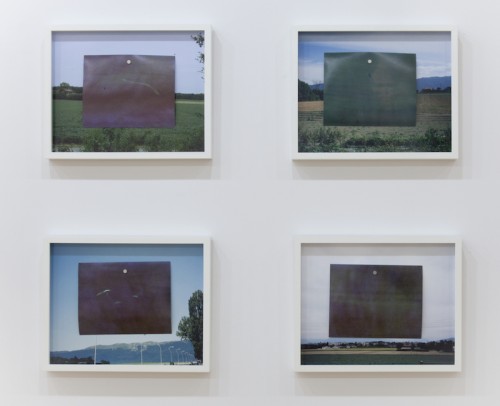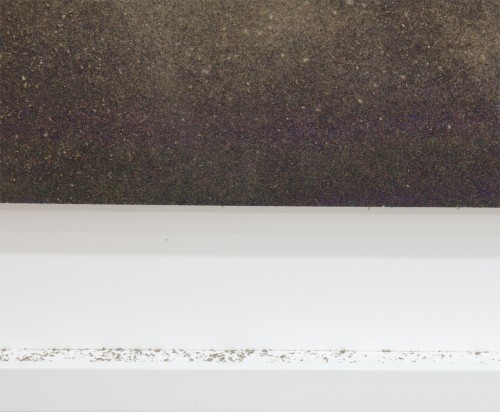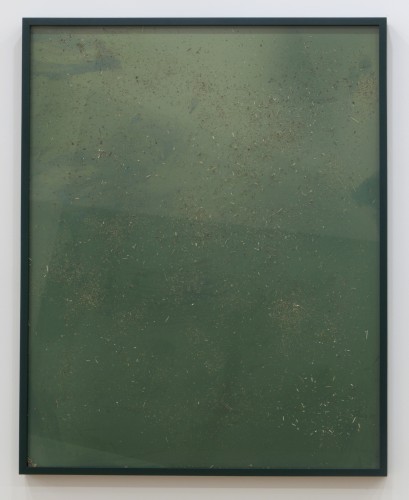CERN, an exhibit of Jeremy Bolen’s documentary photographs, is on display at Andrew Rafacz Gallery until March 30. Here, Bolen presents a series of work that measures phenomena invisible to the human eye. Bolen has made a habit of such investigations. With a solid background in American landscape and survey photography, he has gone on to make the environment itself a lens for exposure, exposing film to bioluminescent plankton underwater by using the lake as a camera lens. He has buried film underground in order to capture traces of buried radioactivity on photographic paper, and exposed film in radioactive rivers.
In this latest series, Bolen spent a week at CERN, the site of the only Large Hadron Collider (LHC) in the world, leaving film in different parts of the laboratory and surrounding landscape to measure the effects of particle acceleration. Bolen’s resulting photographs vary. In some cases we are givin only the ambient, abstract trace of invisible phenomena. In other instances, Bolen inserts a traditional landscape portrait—like a caption—into his ambient fields as a way of presenting another kind of image that explains where the film was exposed. In still other instances, the relationship is inverted: the traditional landscape image of Geneva’s pictueresque environment frames a black square in which we see a slight trace of color: a portrait of anti-matter. Although these images read like abstractions, they are entirely literal. One might even suggest that Bolen is trying to exhaust every mode of site documentation, incorporating different angles of the same location into one frame, while adding site specific materials. At CERN, 600 million collisions occur each second. These collisions are attempted reenactments of the Big Bang. Bolen is working to document the otherwise invisible effects of that staged, scientific reproduction.
Caroline Picard: The photographs in your recent exhibition were taken on site at CERN. I was wondering if you could talk about your residency there and how you spent your time. Was it easy working with scientists?
Jeremy Bolen: I guess it was sort of a residency, but certainly not an official one. Access to places like CERN is extremely complicated, and I am still somewhat shocked that it worked out so well. I stayed in what are essentially the CERN dorms and really felt out of place. Most days I had meetings with physicists and was taken around to control rooms, accelerators, data storage areas and what not. I rented a bike in Geneva (which must be the most expensive place in the world) to explore the massive CERN complex and the areas around France and Switzerland above the Large Hadron Collider, and Lake Geneva, exploring ways to document these areas where multiple realities are always in play.
At night I would take whatever scientists I could wrangle out for drinks and argue about ideas of absolutes, black holes, and time travel. Sometimes they made diagrams with butter packets and salt shakers like in the movies. The scientists that were willing to work with me were amazing.
CP: What do you mean by multiple realities?
JB: There is the reality of the actual landscape, the buildings, the people, the vernacular of the region. But then there is the LHC and all of the support accelerators 350-feet below ground, an entirely separate reality existing below, recreating a past reality in what is supposed to be vacuum. But it is not a vacuum at all, in a myriad of ways what is happening in the LHC alters our current, past and present world. Paul Virillo writes about this in The Great Accelerator:
“The LARGE HADRON COLLIDER of Geneva claims to reveal—live—the creation of the world, no less, at the obvious risk of procreating a ‘black hole’—of low amplitude, the say, no doubt to reassure us about the risks being run…In this ‘speedway’ where the landscape is the lack of landscape, the exodus of the speed of light actually leads to a crash of reason, of ‘common sense’. What then surges up, ex abrupto, is the Accident in Time triggered by a physics that is now the victim of a coma affecting all knowledge acquired here below…”

Jeremy Bolen. “350 feet above the Large Hadron Collider #1 – #4,” 2012. Archival pigment prints, neodymium magnets. 14.5 x 18 in. Courtesy the artist.
CP: Can you talk about the way you juxtapose (or engage) traditional landscape photography and your documentation of invisible phenomena? How do those interests play out in your work?
JB: With photography (in the most traditional sense) you have an endless amount of information that is possible to record, but when you create an image you subtract out almost everything, capturing one instant from one perspective. It is an inherently subtractive process. In all my work I hope to create more additive documents. With this project I create a tension between the familiar representation, the invisible, and the actual. The literal collision between these elements form a more comprehensive image of the landscape, strangely making it less abstract while creating a new sense of presence.
The primary focus at CERN is the Large Hadron Collider, which is buried about 350 feet underground, far enough below the surface that no one even owns the land. It is the largest machine ever created. The idea of the recreation of the instant after the Big Bang happening, rapidly in this massive accelerator below the banal landscape, where 600 million collisions per second are occurring to investigate the nature of nature is extremely captivating…And the idea of these transhistorical events, recreating the beginning of existence as we understand it, while simultaneously altering the present and perhaps altering the way we understand history. There is a confusion between the real and simulated that is fascinating to me.
CP: Do you feel like you are breaking from a tradition of photographic image making? I guess in asking that, I am thinking about Ansel Adams, for instance, when he said that photography is a medium that measures light. You seem interested in using photography as a different kind of medium…to measure something else entirely.
JB: I do feel like a lot of this work is about rethinking the medium of photography, which often gets lost in the science conversation. What I try to capture is the massive amount of information in the electromagnetic spectrum that is beyond our senses, that we cannot perceive. I believe that the apparatus you use for recording has just has much to do with the results as the phenomena you are trying to record. So I rethink the apparatus for every location I work with, often using the actual site as the vessel for recording, or building a new camera to record with. I am trying to record more than just light, but I don’t think I am actually breaking that far from the photographic tradition, as photography has always been in a state of flux, trying to record more accurately, perhaps trying to find a photographic truth. I definitely don’t feel like I need to adhere to any preconceived rules or ideas of what photography is supposed to be.

Jeremy Bolen. “Untitled (CERN 7.20.12),” 2012. Archival pigment print with flora from site and painted frame, 50 x 40 in. Courtesy the artist.
CP: That sort of leads me to my next question—this idea of the photograph as a performance. I feel like you tend to you use photographic film as a membrane that records its own experience. You bury film underground, or use a lake as a camera—can you say more about that? And what does it mean to capture an image or trace of anti-matter?
JB: Yes, I love the idea of the photograph being a record of a performance, and in many instances [my pictures] function in that way. Diving into a lake to use that lake as a camera, digging holes to bury film to record radiation; there are modes of recording through performance and interference used in a lot of my work. The water shifts in Lake Geneva actually alter the shape of the LHC, so that performance of sorts is exactly what I am talking about here. Much of this work merges the trace of a performance with the document of a space or non-space.
I am drawn to working with photography as it can act as an extension of our human senses, and when that can be taken a step further, where it becomes an extension of perception, and a collaboration with the environment it is recording, there is a completeness that I really enjoy. And the film does act as a membrane of sorts, a malleable membrane that can record interactions with light, invisible phenomena and material simultaneously. Creating work in this way creates this really interesting play between planning and chance. Robert Smithson once said, “Planning and chance almost seem to be the same thing,” which is something I have been considering lately.

Jeremy Bolen. “41.70230º -87.91234º (buried at site a, with the first nuclear reactor) #7,” 2012. Archival pigment print with dirt from site, 20 x 25 in. Courtesy the artist.
CP: My last question is about authenticity. You also add material to your photographs—dirt from the site the image was taken, or you’ll wash a photo in a bath from Lake Geneva—how important is it that the material (the grass, the dirt, the water) be taken from its site of origin? And why?
JB: It is imperative that the material is taken from the site of origin. Absolutely. I want there to be an actual presence from the site: the smell, the entropy of the material, the way it interacts with the photographic image. I want there to be a first order experience, and a tension between the real and simulated, the actual and the representational. So I guess I do have some of my own rules.

Jeremy Bolen. (detail) “41.70230º -87.91234º (buried at site a, with the first nuclear reactor) #7,” 2012. Archival pigment print with dirt from site. 20 x 25 in. Courtesy the artist.





Pingback: Art in the Middle: a new interview with Jeremy Bolen regarding CERN | The Lantern Daily
Pingback: Week in Review 03.02.13 | Art21 Blog